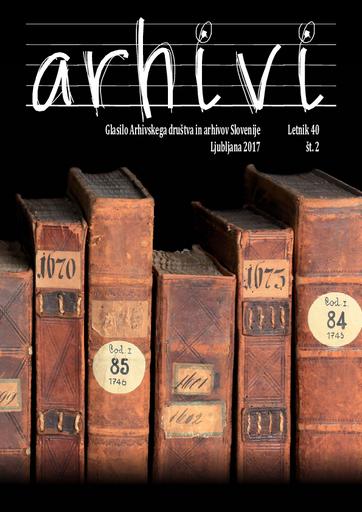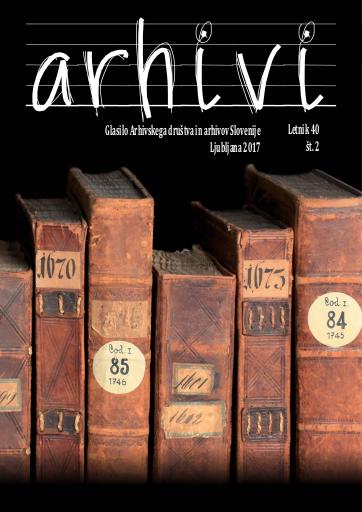/
Serijske publikacije
/
Arhivi
Štajerska kapucinska provinca do Jožefa II.


To delo avtorjev Vinko Škafar, ČLANKI IN RAZPRAVE, Štajerska kapucinska provinca, samostani, dejavnost, povezovanje geografskih prostorov, ARTICLES AND PAPERS, Capuchin Styrian province, monasteries, activity, integrating geographical areas je ponujeno pod Creative Commons Priznanje avtorstva-Nekomercialno-Deljenje pod enakimi pogoji 4.0 Mednarodna
Datoteke (1)

Opis
V razpravi so predstavljeni samostani Štajerske kapucinske province, ki so bili na ozemlju današnje Republike Slovenije, Hrvaške, Avstrije (Štajerska in Koroška) in Italije (zahodni del Furlanije - Julijske krajine, it. Friuli-Venezia Giulia, nem. Friaul-Julisch Venetien). Že dejstvo, da so redovniki Štajerske kapucinske province živeli in delovali med ljudstvom, ki je govorilo nemščino, slovenščino, hrvaščino, italijanščino in furlanščino, govori o povezovanju geografskih prostorov. Od prvega samostana v Gradcu leta 1600 do leta 1711, ko so položili temeljni kamen za najmlajši samostan, Irdning, je provinca imela 33 samostanov in en hospic: 1. Graz sv. Anton 1600, 2. Ljubljana 1607, 3. Bruck an der Mur 1607, 4. Gorica (it. Gorizia, nem. Görz) 1609, 5. Celje (Cilli) 1615, 6. Reka (Fiume) 1609, 7. Maribor (Marburg) 1613, 8. Radgona (Radkersburg) 1617, 9. Zagreb (Agram) 1618, 10. Trst (Trieste) 1623, 11. Ptuj (Pettau) 1623, 12. Krmin (Cormons) 1624, 13. Beljak (Villach) 1629, 14. Wolfsberg 1634, 15. Sv. Križ (Heiligenkreuz) 1637, 16. Leibnitz (Lipnica) 1639, 17. Krško (Gurkfeld) 1644, 18. Kranj (Krainburg) 1640, 19. Tamsweg 1643, 20. Murau 1645, 21. Celovec (Klagenfurt) 1646, 22. Graz (extra muros) (St. Joannes Bapt.) 1648, 23. Gradišče ob Soči (Gradisca)1648, 24. Hartberg 1654, 25. Novo mesto 1658, 26. Cmurek (Mureck) 1667, 27. Leoben 1690, 28. Varaždin 1701, 29. Knittelfeld 1705, 30. Škofja Loka 1707, 31. Schwanberg 1708, 32. Karlobag 1710, 33. Irdning 1711 in 34. hospic Kaniža v Liki 1721. Podobno kot število samostanov je bilo tudi število redovnikov visoko, najvišje leta 1769, ko je Štajerska kapucinska provinca imela 820 članov (duhovnikov, bratov pomočnikov, klerikov in novincev). Podoba province pa se je zelo močno spremenila s posegom jožefinskih reform.
Metapodatki (11)
- identifikatorhttps://hdl.handle.net/11686/41536
- naslov
- Štajerska kapucinska provinca do Jožefa II.
- Capuchin Styrian Province Until Joseph II
- avtor
- Vinko Škafar
- ČLANKI IN RAZPRAVE
- Štajerska kapucinska provinca
- samostani
- dejavnost
- povezovanje geografskih prostorov
- ARTICLES AND PAPERS
- Capuchin Styrian province
- monasteries
- activity
- integrating geographical areas
- soavtor
- Gregor Jenuš (gl. in odg. ur.)
- Dunja Mušič (teh. ur.)
- Petra Markuš (prev.)
- Tanja Martelanc (foto.)
- opis
- In the 18th century, Capuchin Styrian province included 33 monasteries which were an exceptional factor in fostering integration of geographical spaces as their members belonged to five linguistic areas: German, Slovenian, Croatian, Friulian, and Italian which was self-evident at the time since all monasteries were situated in the Habsburg Monarchy. However, Capuchins were aware of their linguistic identity proven by their precious literary creations in four living languages (German, Slovenian, Croatian, and Italian). Friars Minor often changed monasteries as it is well known they do not adhere to stabilitas loci contrary to monastic orders. This can be demonstrated by German P. Erhard Franc Ksaver Kugelmayer from Radgona (1714-1798) who was appointed the Minister General of the Capuchin order and died in Rome in an odour of sanctity. Born in 1714 to German townsfolk, he joined the Capuchins at the age of 17 and found them to be bilingual and operating in the Capuchin monastery in Radgona. In 1745, he was a philosophy lecturer in the Krško Capuchin monastery and four years later, in 1749, he lectured theology in Graz, whilst three years later he served as monastery guardian in Maribor where he stayed three years until 1755 when he was elected Provincial of the great Capuchin Styrian province that included 774 priests. In 1761, he was re-elected as Provincial and a year later he was elected supreme advisor (Definitor General) of the Capuchin order in Rome. When his term of office of Definitor General expired, he was elected Procurator General in 1768 and thereafter twice elected the Minister General of Capuchin order, a position he held between 1775 and 1789. We must also mention the blessed f. Marko of Avian (1631-1699) who attended Jesuit gymnasium in Gorizia and later decided to join Capuchins in Koper (which is in present-day Slovenia), functioned as a preacher in Ljubljana monastery church, and performed mass on September 12th 1683 before the decisive defence battle of Christian army against Turkish attack on Vienna; he now rests in the Capuchin church in Vienna. Even though St. Lawrence of Brindisi who deserves credit for ensuring Capuchins’ arrival in Slovenia and was declared a church teacher, and despite the oldest Slovene dramatic text was written by Romuald of Sant’ Andrea, and that literary historians value the baroque sermons of John Baptist of Sveti Križ in Vipava (Tobia Lionelli, 1647-1714) and f. Roger of Ljubljana (Mihael Krammer, 1667-1728), the Capuchin friars were primarily preachers of the people or, as the Italian like to say, frati del popolo – or to qoute Matej Slekovec, they became »darlings of simple people« (Slekovec 1889, 90). They wanted to be close to the little people, friars among simple people and they were mostly successful in their endeavour. Capuchins welcomed everyone, all worshippers, townsfolk, and countryfolk, simple and educated. Also in mixed linguistic areas, Capuchin friars successfully linked pastoral and other activities; it should also be noted that they cared for the afflicted during the plague and administered sacraments
- založnik
- Arhivsko društvo Slovenije
- datum
- 2017
- 01. 01. 2017
- tip
- besedilo
- jezik
- Slovenščina
- jeDelOd
- pravice
- licenca: ccByNcSa
